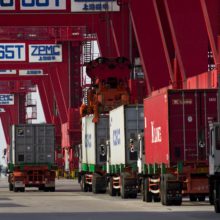
The COA was established in 2005 to represent the interests of all owners of freight containers (both shipping lines and leasing companies), with owners being Full Members, and suppliers of ancillary equipment/services (including flexitanks) being Associate Members. The COA’s flexitank division was established to create a Code of Practice for flexitank companies, which would enable shipping lines to check that the flexitanks they are carrying have been tested correctly and that production and operations have been audited.
The latest COA flexitank meeting gave an update on a number of projects being undertaken, including a revision of the COA Flexitank Code of Practice (which is currently taking place and will be launched in September 2015); and an update on PAS 1008, the publicly available specification published last year by BSI, intended to permit the certification of flexitank materials and flexitank manufacturing.
One of the keynote presentations – an analysis of the global flexitank market – was given by Andrew Watson, COO of Braid Group. Watson projected that the number of flexitank loads in 2015 could be just short of 1 million, having topped 800,000 last year. In 2016 this could even reach just under 1.4 million loads and 1.8 million by 2017.
A regional breakdown of loadings showed Asia to be the biggest point of origin with around 60 percent of shipments, followed by Europe at 15 percent, North America (8 percent), South America (7 percent) and the Rest of the World accounting for 10 percent.
The most popular product categories were non-hazardous chemicals, edible oils, and base oils, each with 20 percent of shipments. Latex and foodstuffs accounted for 15 percent each, followed by wine shipments at 10 percent.
In terms of service categories, full service (supply & fit, plus other value add services) accounted for 20 percent of loadings, supply and fit 35 percent, and supply only 45 percent.
Watson noted that commodity markets generally select the supply & fit or supply only options, while major global majors tended to select a full service package.
Among future developments he foresaw further innovations in the fields of heating, barrier technology, more flexitanks in 40ft containers, PE resin development, specialist mixing systems, greater food compliance in manufacturing.
As previously reported in Bulk Distributor, the COA has now established a Flexitank Management Committee (FMC) to ensure good governance and management of the division.
Five shipping lines were appointed: Maersk Line, Hapag Lloyd, Hamburg-Sud, CMA CGM and MSC. It is worth noting that Maersk, MSC, CMA CGM and Hapag Lloyd are the four largest container carriers accounting for some 43 percent of the world fleet in TEU terms. Hamburg-Sud is the ninth biggest carrier with a 3.1 percent market share.
[pullquote]Asia generally and China specifically will likely occupy much of the division’s time in the next few years[/pullquote]
The five flexitank companies appointed to the FMC are: Braid Logistics, Trans Ocean/Hillebrand, Qingdao Laf, Contralo, and Philton. In addition to the FMC, which will primarily focus on the overall governance, strategy and work programme of the Flexitank Division, a COA Technical Work Group (TWG) has been established.
Any flexitank member that wants to contribute to the technical projects of the TWG can join the group. The TWG will mainly work as a correspondence group by email, and its first project is to review the current PAS 1008 and identify any changes that may be required.
The FMC met on 15 June 2015, to review the progress of the division, with the agenda covering a range of items, including possible approval of the China Railway Test & Certification Centre (CRTCC) and the railway impact facility which belongs to China South Railway Vehicle Manufacturing.
In fact, Asia generally and China specifically will likely occupy much of the division’s time in the next few years. The FMC recognises that the COA needs to work harder to promote its work and projects in Asia, especially China.
Therefore, the involvement and engagement of all flexitank division members in promoting the COA’s work in Asia is now a particular objective of the FMC.

